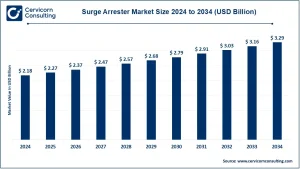Global Energy Transition Market Overview
The global energy transition market is experiencing rapid growth as governments, industries, and consumers accelerate the shift from carbon-intensive energy systems to cleaner, more efficient, and flexible alternatives. The market was valued at approximately USD 21.24 billion in 2024 and is projected to reach around USD 70.57 billion by 2034, representing a CAGR of 12.76% between 2025 and 2034.
This market encompasses a wide range of technologies and segments, including renewable energy generation, energy efficiency, electrification, hydrogen, smart grids, energy storage systems, carbon capture, and digital energy platforms.
From a regional perspective, Asia-Pacific holds a dominant position, accounting for roughly 42.54% of global revenue in 2024, driven by strong deployment momentum in countries such as China and India.
Get a Free Sample: https://www.cervicornconsulting.com/sample/2755
Key Market Trends
1. Electrification and Digitalization of Energy Systems
The expansion of electrification across transport, buildings, and industrial sectors is being reinforced by digital platforms, IoT, AI-driven optimization, and energy management systems. These technologies enable intelligent grid balancing, demand response, predictive maintenance, and efficient asset utilization, allowing variable renewable energy sources to integrate more reliably.
2. Declining Costs and Efficiency Improvements in Renewables and Storage
Ongoing cost reductions in solar PV, wind turbines, battery storage, and power electronics are making energy transition technologies more economically feasible. Improvements in module efficiency, inverter technology, and battery chemistry further enhance project returns.
3. Emergence of Hydrogen and Green Fuels
Hydrogen, particularly green hydrogen produced from renewables, is gaining prominence as a flexible energy carrier and a decarbonization solution for hard-to-electrify sectors such as industry and heavy transport. It also provides a grid-stabilizing buffer, with increasing investment and policy support globally.
4. Intensified Regulatory and Policy Measures
Governments are strengthening climate policies through carbon pricing, renewable mandates, green subsidies, and electrification incentives. Such measures create demand pull, reduce investor risk, and accelerate the adoption of clean energy solutions.
5. Consumer and Corporate Sustainability Commitments
Growing corporate and consumer focus on net-zero goals, renewable energy procurement, and decarbonization is driving demand for clean energy systems. This includes purchasing renewable energy certificates and deploying distributed energy solutions.
Market Drivers
Growing Energy Demand and Electrification
Population growth, industrialization, and transport electrification are driving the need for clean power generation, fueling market expansion.
International Commitments and Net-Zero Targets
Binding climate targets and decarbonization mandates are reshaping national energy strategies, supported by subsidies, carbon pricing, and green financing.
Technological Advances and Cost Reductions
Solar, wind, battery storage, and hydrogen technologies are becoming increasingly cost-competitive, supporting adoption in both developed and emerging markets.
Policy and Regulatory Incentives
Instruments like carbon taxes, feed-in tariffs, green bonds, and tax credits continue to drive investments in clean energy infrastructure.
Corporate and Consumer Pressure
Rising ESG expectations and demand for sustainable solutions push companies to adopt renewable energy and energy-efficient systems. Quantitatively, the market’s projected 12.76% CAGR from 2025 to 2034, reaching USD 70.57 billion, reflects the strength of these drivers.
In Asia-Pacific alone, the market is expected to grow from USD 9.04 billion in 2024 to USD 30.02 billion by 2034, highlighting the region’s central role.
Impact of Trends and Drivers
By Segment / Technology
-
Renewables & Storage: Core of transition efforts, accounting for nearly half the market in 2024.
-
Electrification & Smart Grids: Advanced in developed economies and rapidly accelerating in emerging markets.
-
Hydrogen & Clean Fuels: Key enabler for industrial and transport decarbonization.
-
Carbon Capture & Storage (CCS): Still niche, dependent on regulation and project economics.
By Region
-
Asia-Pacific: Leading the market with strong policy support and investment momentum.
-
Europe: Driven by regulations, carbon pricing, and clean energy mandates.
-
North America: Growing investments in storage, renewables, and hydrogen hubs.
-
LAMEA: Selective adoption, with notable projects in Brazil, UAE, and South Africa.
By Application
-
Utility-Scale Power: Primary focus of renewable deployment.
-
Commercial & Industrial: Corporations adopting clean energy to meet sustainability and cost objectives.
-
Residential: Increasing adoption of rooftop solar and home batteries.
-
Transport: Expansion of EVs and hydrogen fuels reshaping mobility.
Challenges and Opportunities
Challenges:
-
Grid integration of variable renewables.
-
High upfront capital and financing risks.
-
Emerging technologies like long-duration storage and hydrogen infrastructure.
-
Regulatory uncertainty and permitting delays.
-
Land and resource constraints for large-scale projects.
Opportunities:
-
Growth in emerging markets.
-
Hybrid energy systems combining solar, storage, hydrogen, and digital platforms.
-
Corporate decarbonization initiatives in heavy industries.
-
Green financing and carbon market mechanisms attracting capital.
-
Digital platforms for peer-to-peer energy trading and virtual power plants.
Future Outlook
The energy transition market is expected to sustain double-digit growth, with revenues projected to rise from USD 21.24 billion in 2024 to USD 70.57 billion by 2034.
Key developments shaping the next decade include:
-
Scaling of green hydrogen as costs decline.
-
Expansion of long-duration storage to stabilize grids with high renewable penetration.
-
Growth of smart grids and digital energy platforms for real-time optimization.
-
Accelerated corporate offtake and PPAs as companies pursue net-zero targets.
-
Regional leadership solidifying, with Asia-Pacific leading, followed by Europe and North America in advanced clean energy technologies.
The coming decade will be defined by integration, innovation, and scale, as falling costs, supportive policies, and consumer demand converge to accelerate the global transition toward clean energy systems.

